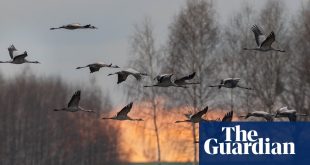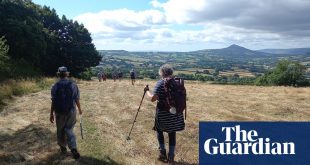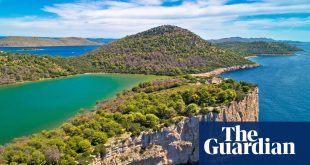The sand outside the windows stretches for miles. The sea is glinting in the distance and there are egrets standing guard along the estuary, their white feathers bright against caramel-gold sandbanks. “Could be the French Riviera. Look at it!” says one of my fellow passengers, waving his arm at the expansive views. His enthusiasm, partly fuelled by cans of morning cocktails, is not misplaced. The scenery gets better and better as winding saltmarsh gives way to the rising fells.
Much of Cumbria has become too popular for its own good. But if you visit the overlooked coast and access the famous lakes without a car, you’ll find deserted beaches and unbeatable countryside without adding to the traffic. The swaying Avanti West Coast train from Euston to Lancaster takes just two-and-a-half hours to speed 250 miles while the leisurely Northern railway round the Cumbrian coast takes nearly as long again to cover less than half that distance. But this is a journey worth savouring. Each station and stretch of track has a distinct atmosphere, from the retro-romantic tea room at Carnforth, where 1945’s Brief Encounter was filmed, to the trackside Ratty Arms and flowerbeds at Ravenglass.
I’ve been hoping for a reason to revisit Ravenglass since my last trip three years ago and now two new things to interest car-free travellers have come along at once: the free weekend shuttle bus to beautiful Wasdale this summer runs through from Ravenglass station in the morning and back in the evening (until 4 September). And new stretches of the England coast path around Cumbria have opened, which are easy to get to by rail, taking walkers through sand dunes and post-industrial nature reserves.
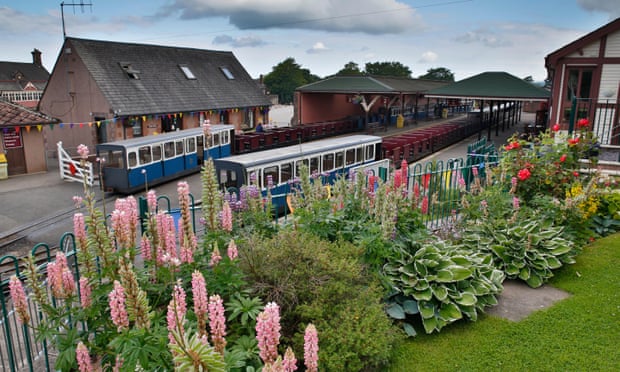
Sam Bowden runs the Ravenglass Handmade Ice-Cream company with her family. They opened a new shop in June and the most popular flavour is sea buckthorn. There are inns nearby, next to the estuary, just minutes from the station, but this time I’m staying in the grounds of Muncaster Castle. Fuelled by rhubarb and ginger ice-cream, I hike a mile or so up through the woods to find the old granary, a converted barn that sleeps four. It’s part of the castle’s unpretentious Coachman’s Quarters. There are more self-catering rooms, including a dorm with four bunkbeds, across the courtyard with a communal kitchen and sitting room.
The USP is after-hours access to Muncaster’s 77 acres of gardens. Paths climb through jungles of rhododendron and magnolias. There is a huge panorama from the mile-long terrace with its neat yew trees and borders full of tiger lilies. The view was once described by Victorian writer John Ruskin as the “gateway to Paradise”: the winding River Esk gleams blue and the fells flush scarlet in the setting sun.
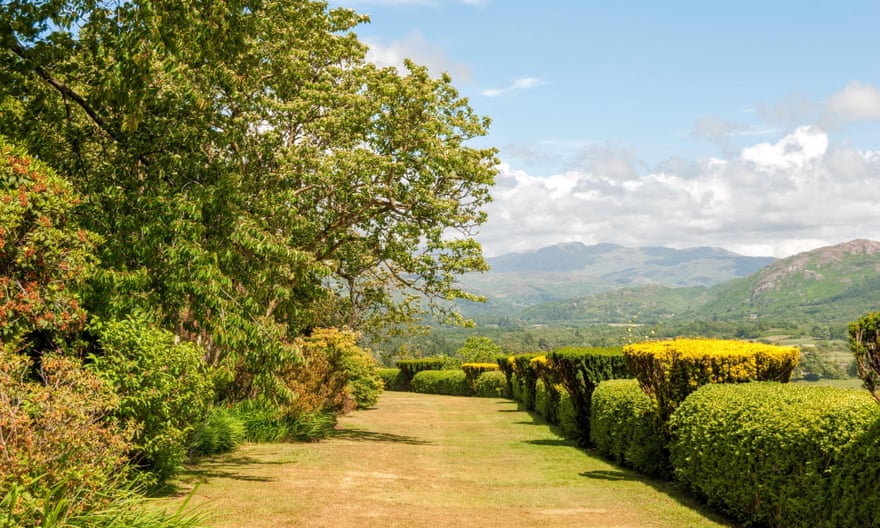
The logo for the Lake District national park is a stylised version of the view northwards along Wastwater towards fell-flanked Great Gable. Voted “favourite view” by an ITV poll in 2007, the valley often draws more than a quarter of a million visitors a year, causing queues of cars and campervans along the narrow scenic lanes of the Wasdale valley. The Wasdale shuttle aims to ease the weekend pressure and cut carbon emissions.
The minibus stops to pick up a party of hikers from Cologne. “Weather like Italy and a free bus. What more could we wish for?” says Dirk Hertel. We all get off at the Wasdale Head Inn with rows of old climbers’ boots and ice axes over the mantelpiece. Tracks lead from here up Scafell and other mountains. The inn’s Victorian landlord, Will Ritson, famous for tall tales, gave his name to a nearby waterfall, Ritson’s Force.
Previous Cumbrian walking holidays have often involved trudging through rain and warming up by pub fires. Today, I’m striding under blazing blue skies and cooling off in lakes and rivers. I cross a little stone bridge and climb past rosebay willowherb and the yellow starry flowers of bog asphodel. Ten minutes later, I’m floating in turquoise water under pine branches with the waterfall cascading into a pool above me. I head back down for a coffee at the Barn Door and set off along the valley on a steam-side path.

The path along the screes on the far side of Wastwater looks far too much like hard work, but the little road I stick to instead is plagued by the traffic the Wasdale shuttle is trying to mitigate. Luckily, the bus can ferry walkers to the Greendale junction. Walk along the lakeside lane for half a mile until a path leads off through trees. I stop for another swim from a shingle beach under the branches: the water is bracing and the scenery spectacular.
Scafell Pike, at 978m, is England’s highest mountain and Wastwater is England’s deepest lake. It’s this depth that keeps the water cool year-round and my feet start feeling icy after 10 minutes, so I crawl out and dry them on sun-warmed pebbles. Nether Wasdale has a choice of pubs and farm shop cafes, including the relatively new Sawmill. I have tea on its waterside terrace and half an amber ale called Errmmm… from the Strands microbrewery, before flagging the bus down outside
A friend is joining me for the second day’s walking. I meet her at the station and we have dinner at the village’s newly reopened Inn by the estuary in Ravenglass. The food and drink are exceptional: we eat charred mackerel with watercress, garden pea falafels with pickled beetroot, courgette fritters with feta, and drink fresh, not-too-sweet homemade elderflower cordial.
The long summer evening smells of hot bracken, cut grass and meadowsweet. I lead the way up through the woods, over the sheep fields, and down through the gardens, pointing out the ruined Roman bath house and the sandstone walls of Muncaster Castle as proudly as if I’d built them myself. We see a hare lolloping over the lawns, a heron flying slowly across the valley, and house martins flitting to their mud nests in the corner of almost every window of the castle and its outbuildings, including our granary.
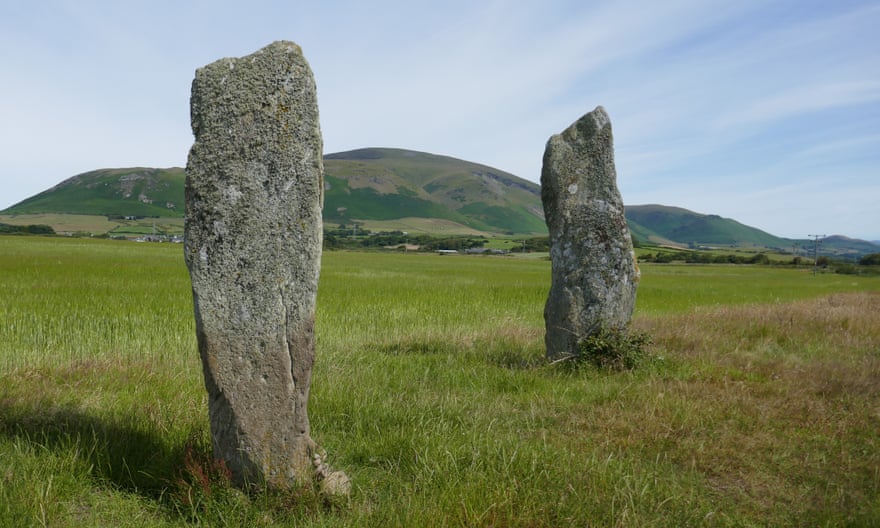
We have coffee next morning at the Turntable cafe by the little steam railway and watch the first train puffing off towards Eskdale before we head to the Northern railway train next door and ask the guard if we can get off at Silecroft station (£3.50). “It’s a lovely journey this. You never get bored of it,” he says cheerfully.
The ambitious England Coast Path, due at 2,795 miles to be the world’s longest coastal walking route, is opening in stages. Current plans, delayed by Covid, could see it finished by 2025. Last year, a 40-mile stretch south from Whitehaven opened, followed in February 2022 by 11 miles from Silecroft to Green Road. This is the section we’re following, as far as Millom, and we start with a short detour to see two standing stones called the Giant’s Grave. They are tall, carved with cup marks, and backed by the frowning bulk of Black Combe. We catch up with the well-signed coast path and emerge on the pebbly beach just as the lower tide sand emerges, perfect timing for a swim.
The path winds through the flowers that cloak the side of Haverigg dunes: wild thyme, bedstraw, sheep’s-bit, bright pink centaury and delicate purple dune pansies. We stop for homemade cake at the Haverigg beach cafe before setting off along the sea wall, which circles a flooded iron ore mine. There are plans to enhance this area as a visitor attraction called Iron Line, drawing on its natural and cultural heritage.
Great crested grebes are swimming on the water and terns with beaks full of small silver fish fly over the path just in front of us, heading for their nests nearby. Looping through this RSPB reserve, past two old lighthouses and a ruined windmill, views open up across the wide sands of the Duddon Estuary towards the fells beyond. Inland, we can see the spire of St George’s Church in Millom.
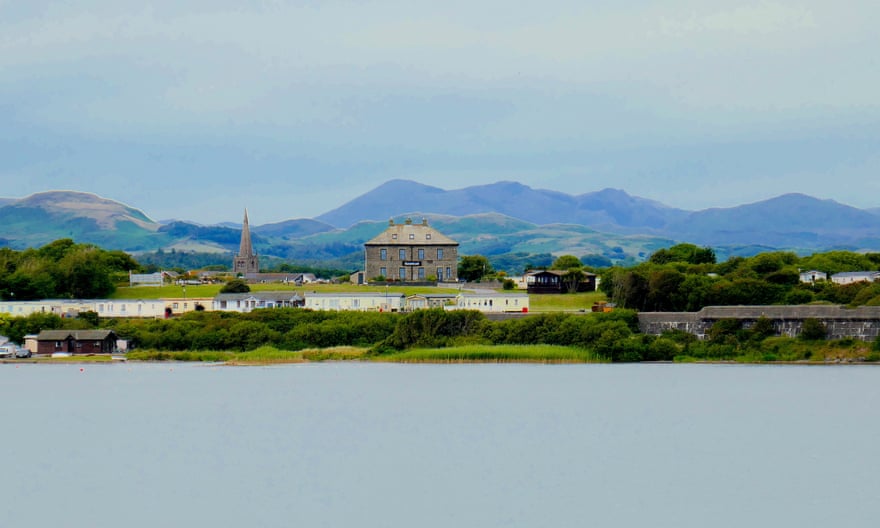
The Cumbrian poet Norman Nicholson (1914-1987) lived in Millom and, with prescient environmental concern, celebrated this coast in his landscape poetry. Last year, an app was launched with heritage trails that trace the writer’s footsteps. He describes the lagoon we’ve just passed in Hodbarrow Flooded:
Where once the shafts struck down through yielding limestone
Black coot and moorhen
Lay snail-wakes on the water
From Millom station, we catch the train to Manchester via Barrow. Cancelled services mean we don’t arrive until midnight, but it’s worth it. One of the few good things about this delayed journey is watching the sun sink into Morecambe Bay, where the ribbed sands shine pink and the distant fells glow purple.
 Top Naija News: Nigerian News, Breaking News Nigeria and World News Top Naija News is a daily news publication in Nigeria, delivering the latest breaking news in Nigeria and around the world.
Top Naija News: Nigerian News, Breaking News Nigeria and World News Top Naija News is a daily news publication in Nigeria, delivering the latest breaking news in Nigeria and around the world.
